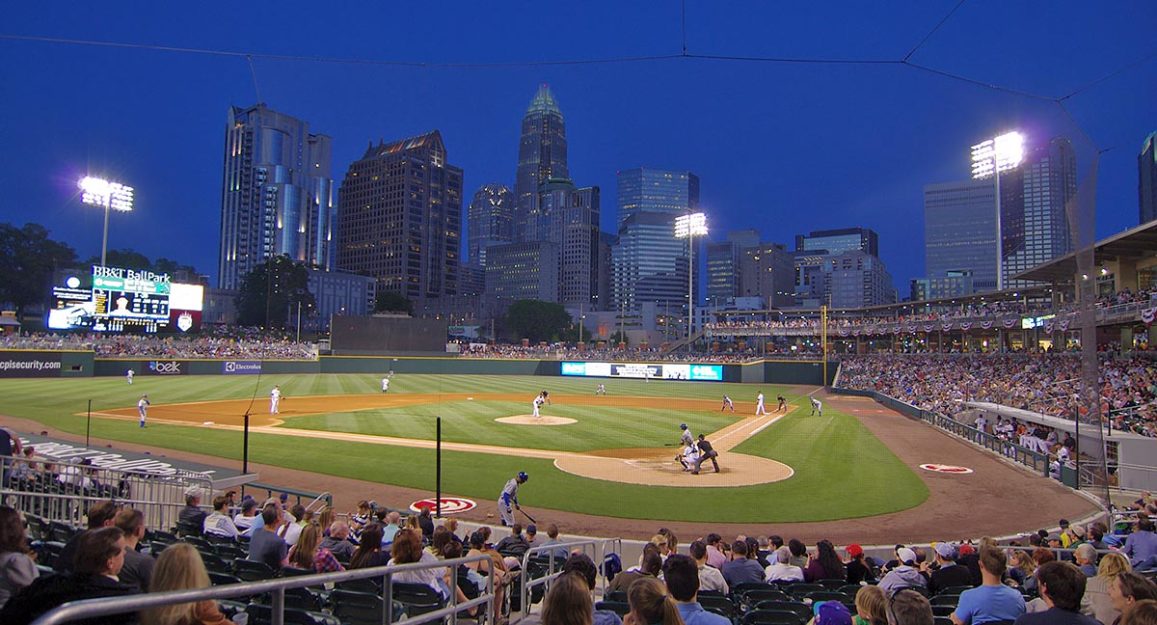By Joe Mock, BaseballParks.com
All rights reserved
Most metro areas have an area that is considered to be "downtown" and surrounding areas that can be categorized as "suburbs." Not Charlotte, NC. Its downtown area is always referred to as "uptown."
|
Ballpark Stats |
|---|
 |
| Team: Charlotte Knights of the International League |
| First game: April 11, 2014, an 8-6 loss to Norfolk |
| Capacity: 10,329, of which 7,788 are fixed seats |
| Architect: Odell and BallparkDesignAssociates |
| Construction: joint venture of Rogers Builders, Barton Mallow and Leeper Construction |
| Price: $61 million is the "all-in" total |
| Home dugout: 1B side |
| Field points: East |
| Playing surface: a blend of Bermuda Grasses |
| Betcha didn’t know: The architects calculate that exactly 702 fans can stand at the drink rails at the same time |
During my visit to Charlotte, I asked several people why that is … and I received a different answer from each person I asked. One told me that the well-to-do suburbs, unlike many large cities, are to the south of downtown. Therefore, when looking at a map, the downtown is actually "up" on the map — hence "uptown." Another told me that
the very center of downtown is one of the highest elevations in the city — hence "uptown." Still another told me that it was a conscious effort on the part of the City government or chamber of commerce some decades ago to attach a certain high-society sound to the City’s center — hence "uptown."
Regardless of the reason why it’s called what it’s called, Charlotte’s uptown is now a decidedly more interesting place. That’s because the city’s triple-A baseball franchise has returned from a 24-year pilgrimage out in the way-way-out suburbs. In fact, the Charlotte Knight’s woeful excuse of a baseball stadium was located in another state in Fort Mill, South Carolina.
While playing at "Knight’s Castle" in Fort Mill, the attendance was typically near the bottom of the International League. You can’t blame the area’s baseball fans for failing to make the trek. Traffic and the sterile facility made sure of that.
The Knights had been wanting to move back to Charlotte for years. In fact, the City of Charlotte, Mecklenburg County and the Knights were all in agreement on doing exactly that starting in about 2005. However, one man deserves the lion’s share of blame for preventing that from happening until 2014. His name is Jerry Reese.
"April of ’09. The way it was tracking, we would’ve opened the ballpark in April of ’09," said Dan Rajkowski, the Knight’s Executive VP and Chief Operating Officer when I asked him if Mr. Reese’s constant lawsuits had delayed the building of a new ballpark. "It cost the citizens of Charlotte professional baseball for several years … and tax dollars and legal fees."
Mr. Reese, you see, is a real estate attorney. He had two goals in mind, according to published reports and past interviews with him. He thought Charlotte deserved to have a Major League Baseball team, and if the City built a Minor League park, the Majors would never come. And perhaps more importantly to him, it appears he wanted to make money from the development of the land around the big-league ballpark that would be built.
So he filed lawsuit over lawsuit. He sued the City saying they didn’t have the right to do a "land swap" to provide the land for a park. He sued over the use of public funds for the project. In all, he filed an amazing seven lawsuits attempting to block the building of a stadium for the triple-A Knights.
Using baseball lingo, Reese went 0 for 7, as all seven of the suits resulted in a loss or dismissal — but not before five years had been lost and a pile of tax-payer dollars spent fighting the suits. Channel 9 News in Charlotte reported that the delays caused the cost of building the stadium to skyrocket by $40 million. That seems unlikely, but it was certainly a costly situation for the City and the team.
|
Way out in the ‘burbs |
|---|
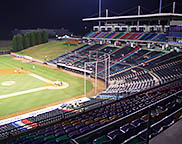 |
| From 1990 through the 2013 season, the Knights played across the state line in Fort Mill, SC. The sterile design was intended to be one piece of an NFL or MLB stadium. That never happened. |
"As an organization, that’s behind us now," Rajkowski said, taking the high road. "We are in a great situation in which we have a beautiful ballpark."
Indeed. And the Knights aren’t looking at this as an experiment to see if downtown baseball will work in Charlotte. No, they are fully committed, having signed a 49-year lease to play in BB&T Ballpark.
They certainly learned that playing in another state didn’t generate fan loyalty within the population of Charlotte, even though Fort Mill is on the border of North Carolina and South Carolina and can be reached from uptown Charlotte in under 30 minutes when traffic is light. Usually in the early evening, though, it was anything but light.
And attendance was very poor, despite playing in the 23rd largest metro area in the country, according to the Census Bureau. Starting in 2009 when the team should’ve been moving into a new park, the Knights finished last in attendance in the 14-team International League in four of the next five years. The one time they escaped the cellar was in 2012 when the Scranton/Wilkes-Barre Yankees had to play away from home the entire season while their ballpark was being rebuilt. In other words, it was five years of horrible attendance, which cost the franchise untold revenue compared to being in a new park.
Consider this: after a month in their new digs, the Knights were actually leading the IL in attendance by a wide margin. Truly a worst-to-first turnaround.
Is it just the location that is bringing sell-out crowds to BB&T BallPark? Or can we give the facility itself some credit? Read on as we take a closer look at the park’s site, exterior, interior design and fan amenities.
And in case you’re curious if Jerry Reese will attend a game at the new ballpark he fought so hard to block, he told Erik Spanberg of the Charlotte Business Journal, "I suspect not. I’m not impressed,"
The Setting
The team knew what they didn’t want regarding their new ballpark. They didn’t want it to be out in Charlotte’s suburbs.
After 24 seasons in Fort Mill, the team wanted to join the trend of Minor League franchises moving back to the center of their core cities. In just the last few years, teams in Stockton, Fort Wayne, Pensacola, Tulsa, Birmingham and El Paso have built new parks right downtown, after having their pro ballparks out in the suburbs — and some of them were really, really far outside of downtown. The results from moving downtown in these cities have been uniformly spectacular.
It’s true in Charlotte, too.
 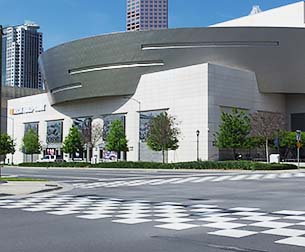 |
Rajkowski pointed out that a typical Minor League team could draw fans from 20 to 30 miles away. "When you’re in Fort Mill, (the 30-mile radius) is only hitting the center part of the City of Charlotte, and you’re missing all of the north (suburbs) and a significant portion of east and west," he added. When your ballpark is in the middle of uptown Charlotte, that same radius hits about 1.2 million people, he said.
Charlotte’s downtown — er, uptown — was also where you’d find the immense NFL stadium (above left, rising above the top of the ballpark two blocks away), their pro-basketball and hockey arena and the NASCAR Hall of Fame (above right). To say it needed a baseball park to complete the picture was an understatement.
After examining a couple of possible sites, the perfect location was determined. Just east of the Panthers’ Bank of America Stadium was a two-block area that would be near football parking lots and numerous downtown parking garages. Further, it would be adjacent to a municipal park that was in the planning stages.
The problem was that the eight acres weren’t under Government control. The clever solution was to engineer a land swap. Michael Smith of an organization called the Charlotte Center City Partners engineered the arrangement where four different groups traded parcels of land. In the end, the County ended up with the two blocks that included a vacant lot and an abandoned building. That land, valued at $22 million, is now being leased to the team for $1 a year. In exchange, according to Rajkowski, the Knights agreed to be responsible for about 75% of the total cost of the project, which they accomplished with loans, selling the naming rights of the stadium and bringing on three corporate "founding partners." The remaining 25% is shared equally by the City and County, with a hard-dollar investment of about $8 million apiece.
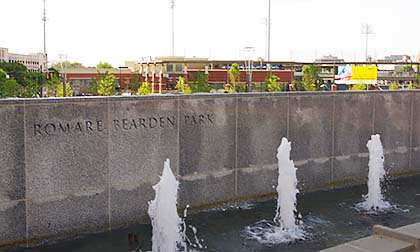 |
That municipal park, which actually opened the year before the baseball park, is indeed located right across Mint Street. Romare Bearden Park is named for an African American artist who was born about a block from the park that bears his name. "He was known for his very colorful collages, depicting scenes of growing up in Charlotte and Mecklenburg County," said Mike Woollen, Managing Principal at Odell, the Charlotte architecture firm that did much of the design work on the ballpark. The part of the park closest to BB&T BallPark is "like a mall, where outdoor concerts can be held. As you get closer to the City (buildings), it becomes more urban, with waterfalls, fountains, LED lighting and small-group seating," he added. A great neighbor for the baseball facility.
The municipal park is bounded on the north by 3rd Street, which used to run through the property now occupied by the ballpark. The shot on the left below shows that this street now ends where the footprint of the stadium begins.
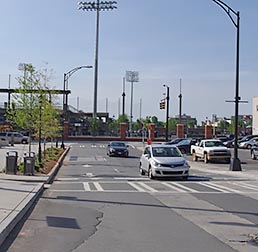 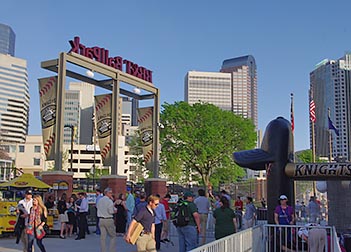 |
And to give you an idea of how close the City’s major buildings are to BB&T BallPark, look at the shot on the right above. It was taken from the outfield concourse, near the entryway at the northeast corner of the site.
Just because the County was able to provide two full blocks for the Knights’ new facility, that didn’t mean that it was smooth sailing in figuring out how to configure the ballpark’s components. "It’s really a challenging site. A really tight site," observed Martin DiNitto, former designer at Populous who left to form BallparkDesignAssociates. He worked closely with Odell on BB&T BallPark’s architecture. "You can see that in our short dimensions to right field and lesser facilities on the third-base side … we really had to get our creative juices flowing to overcome these challenges." He then chuckled and added, "We had to use a big shoehorn to make (the ballpark) fit into that site!"
"In the north-south direction, we had a pretty good amount of room," Woollen said. "On the north (left field) side, there’s a berm, which is where there’s space for future commercial development," which is likely to be a hotel or similar structure (see below). "East-west, though, was very constrained." We’ll delve further into that in our section on the ballpark’s interior.
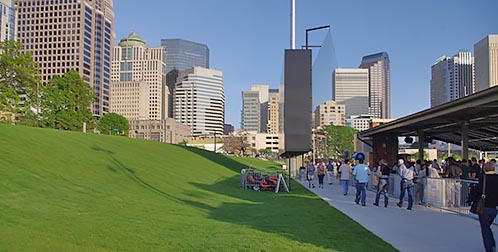 |
Interestingly, the new ballpark is only 2.5 miles from the site of Charlotte’s longtime Minor League facility, Jim Crockett Memorial Park. I checked the location out while in Charlotte. What was once a ballpark for almost six decades is now a nice middle-class neighborhood in the part of town called Dilworth, with single family homes and condos. There was no hint that a ballpark used to be there. It could really use some sort of plaque — although, as we will see, it is commemorated on the exterior of BB&T BallPark.
The Exterior
As you’ll see in our review of El Paso’s new ballpark, an enormous amount of attention is directed toward the colors and types of building materials in a ballpark’s exterior, especially when it’s in an urban setting with lots of nearby structures. After all, the park has to cohabitate with the exteriors of those buildings.
 |
DiNitto and Woollen and their staffs had to spend a lot of time conferring with the organizations who oversee what’s allowed for UMUD (Urban Mixed-Use Development) structures in uptown Charlotte. For instance, no exterior wall could be blank for more than 20 feet at a stretch. There are also rules for how wide sidewalks have to be, and underground utilities have to be considered. All of these things played roles in the way BB&T BallPark was arranged — particularly its exterior.
And this has to be done while keeping in mind that this is a facility for baseball, after all. "We wanted to be traditional in respect to the tradition of baseball," said Woollen.
After joking that more than one ballpark built in recent years has red bricks and exposed steel painted green, Woollen explained that "we lightened the look … We used a lighter shade of brick to look like a number of other buildings in the Third Ward of Charlotte." He added that they used "warm gray paint on the steel instead of green." No repeat of Camden Yards here!
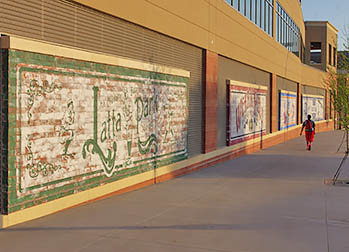 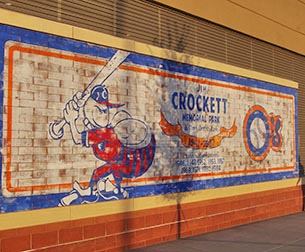 |
"We had some retro signs hand-painted on the outside, to recall the past ballparks of Charlotte," DiNitto pointed out. These beautiful murals are on the west side of the park, along Graham Street. Note that even though these were recently painted, the artist made them look old and weathered. The most noteworthy of Charlotte’s old parks is, of course, Crockett. It was way more noteworthy than the sterile place the Knights just left.
Three of the four corners of the ballpark feature entryways. The lone exception is the southwest corner, at the intersection of Graham and Martin Luther King Blvd (below left). There’s a rotunda, but no access to the outside world. "Initially we had planned an entry at the rotunda, but the flat 360° concourse around the ballpark became a priority," Gaurav Gupte, Project Architect and Designer at Odell, told me. "This meant that the sidewalk elevation was too low to accommodate an entry with ramp. Also, not many pedestrians were anticipated from that corner of the site." Hence, no entryway. He added that the rotunda could be used as a team hall of fame or food court one day.
By the way, many thanks to Gaurav for the guided tour he gave me. And many thanks for the hard work of Jonathan Blain (the architect of record for the project who also oversaw the day-to-day construction work), Gaurav and everyone else at Odell, without whom the ballpark wouldn’t have been ready by opening day.
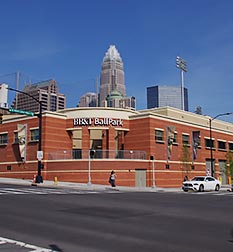 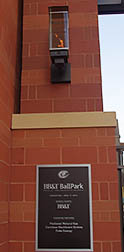 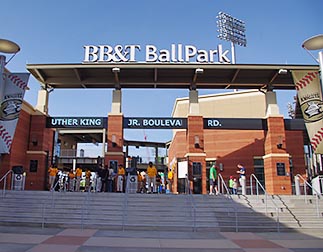 |
The entries at the northern corners of the property both require fans to walk down 10 to 12 feet worth of steps. That’s because of the sloping nature of the site — and to make things even more challenging for the architects, the Graham Street side of the site and the Mint Street side slope upward at different angles. Slide rule anyone?
The main entry plaza at the corner of Mint and MLK is a beauty (above right). Because it is at the lower end of the property, fans have to walk up six feet of steps to get to the concourse. The center photo above not only gives a closer look at the brickwork, it shows the operational gas lamps. Gupte explained that these were installed because one of the founding sponsors of the ballpark is Piedmont Natural Gas.
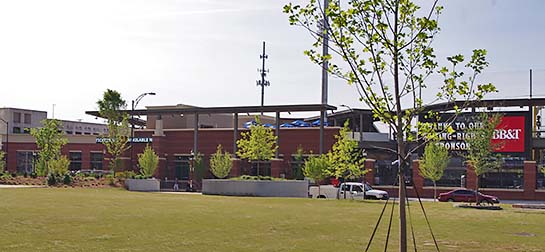 |
One of the most innovative aspects of the exterior is something that is very visible from Romare Bearden Park.
"It’s such a neat opportunity to have this brand-new park right next to the ballpark," DiNitto remarked. "You can close down a street and have concurrent events (happening) in both (venues). With that in mind, we suggested putting another video panel on the outside of the Home Run Porch (of the stadium) that will broadcast out toward the park." The screen (shown on the right side of the photo above) is used to advertise the team’s sponsors and publicize upcoming games and promotions. After all, a lot of pedestrian and vehicle traffic travels up and down Mint Street.
And maybe the best feature of all on the exterior? There are numerous stretches of iron fencing where passersby can look right into the park. I bet it makes them want to buy a ticket and come in.
Let’s now turn our attention to the park’s interior.
